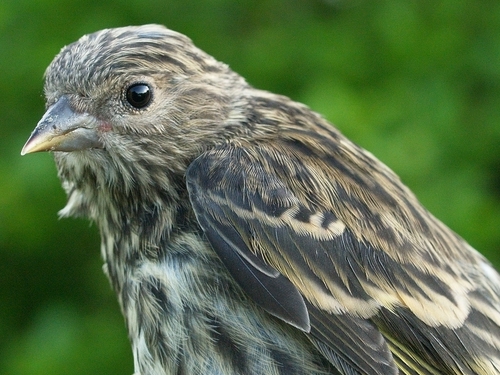|
|
THIS WEEK |
THIS SPRING |
2011 TOTAL |
SITE TOTAL |
|
# birds (and species) banded |
248 (36) |
870 (62) |
941 (66) |
32510 (107) |
|
# birds (and species) repeat |
52 (14) |
124 (25) |
132 (25) |
5639 (68) |
|
# birds (and species) return |
9 (6) |
58 (17) |
82 (17) |
889 (37) |
|
# species observed |
94 |
135 |
139 |
202 |
|
# net hours |
406.0 |
2196.0 |
2219.0 |
51836.1 |
|
# birds banded / 100 net hours |
61.1 |
39.6 |
42.4 |
62.7 |
|
|
Note: table does not include nocturnal banding (owls) |
Banders-in-charge: Simon Duval, Gay Gruner
Intern: Matthew Von Bornhoft
Assistants: Nicolas Bernier, Sue Bishop, David Davey, Rui De Jesus, Leah den Besten, Sarah Dixon, Philippe Dunn, Tammy Elliot, Marcel Gahbauer, Lisa Keelty, Diana Kirkwood, Betsy McFarlane, Barbara MacDuff, Ahmad Shah, Patricia Stotland, Elise Titman, Rodger Titman
Notes: True to form for this spring, we again had periods of rain this week, and the back pond remained high enough to keep net H1 out of commission. Despite being unable to use one of our most productive nets, the number of birds banded this week was consistently good, leading to the second-highest total for a spring week ever, behind only the 299 individuals banded in week 8 of 2009. Combined with the above-average numbers to date this season, this week's results pushed us to a new record high count for the spring migration monitoring program at MBO, eclipsing the 828 birds banded in 2008, with a few days of banding yet to come in week 10.
Before we get into the details of this week's activity at MBO, we want to highlight the efforts of the five teams that participated in this year's Baillie Birdathon to raise funds in support of MBO and the James L. Baillie Memorial Fund for Bird Research and Preservation. The MBO Green Team got things started on May 14, spending most of their time on foot at MBO and the Morgan Arboretum, and tallying 87 species despite enduring rain for most of the day. On May 18, the Red-eyed Wearios (our most successful team of fundraisers) explored southwestern Quebec and the eastern tip of Ontario, reaching a total of 107 species. On May 22, Marie-Anne Hudson and Marcel Gahbauer (lacking a snappy team name) found 92 species in and around Ottawa. The next day, Marcel joined up with the Raven Loon-a-tits for a Quebec-only Birdathon that stretched from Mauricie National Park to Dundee in the very southwest tip of the province, and produced a count of 142 species. The same day, the Laughing Bonaparte's (a welcome new addition to our group of teams this year) reached an impressive total of 160 species by exploring various sites around Kingston, Ontario. We heartily thank all participants for their time in the field and efforts at fundraising, and strongly encourage all our readers to check out the reports below, and make a contribution to the team of your choice if you have not already done so. As of May 31, we have raised just over $8,500 ... please help us reach $10,000!
MBO Green Team |
|
|
Red-eyed Wearios |
|
|
Marie-Anne Hudson |
|
|
Raven Loon-a-Tits |
|
|
Laughing Bonaparte's |
|
|
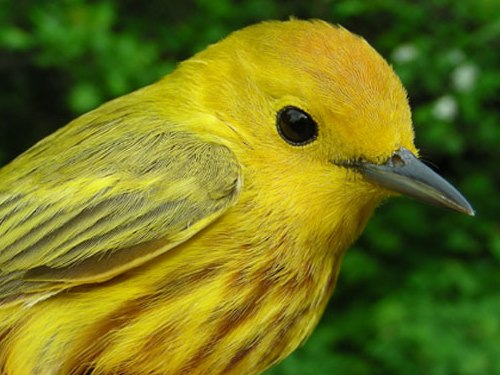
This male Yellow Warbler is a great example of the insights gained from long-term monitoring. We banded it as an after-hatch-year bird on August 12, 2005, and recaptured it this week. By now it must be at least 7 years old, and even assuming a straight-line distance to the closest wintering grounds in Cuba, it must have flown a total of at least 35,000 km just on migration by now!
(Photo by Gay Gruner)
|
Meanwhile back at MBO, the rain this week was more cooperative than usual, in that it fell mostly in the afternoon and overnight, so there was only one morning with net hours severely curtailed due to weather. Species diversity remained high this week, with daily estimated totals reaching between 55 and 58 on all but two days, and ranging from 44 to 67 overall. Both the number of species (36) and individuals (247) banded this week were new high counts for week 9. However, the total of 56 returns so far this spring remains well below the range of 73 to 110 recorded at this point of the season over the past five years, and is a particularly noteworthy deviation since the count had been increasing steadily each year since 2006. We will explore this result in more detail in the full seasonal report.
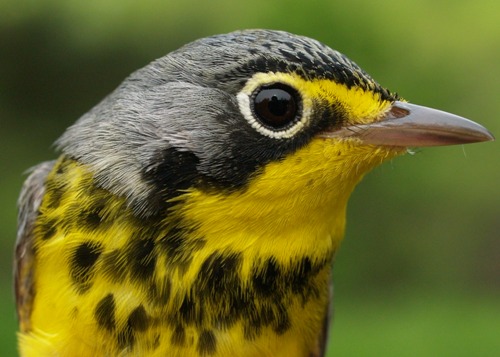
Canada Warbler is always uncommon at best at MBO, and especially so in spring, with season totals ranging from 1 to 5 individuals banded. We were therefore very pleasantly surprised at banding 3 individuals on May 25, and 7 over the course of the week, including this male.
(Photo by Simon Duval)
|
By this time of spring, the number of new arrivals is tapering off, but we still had six species observed for the first time this week: Black-billed Cuckoo, Chimney Swift, Alder Flycatcher, Yellow-bellied Flycatcher, Philadelphia Vireo, and Carolina Wren. The wren was observed for just the second time in MBO's history, the previous sighting having been on June 2, 2009.
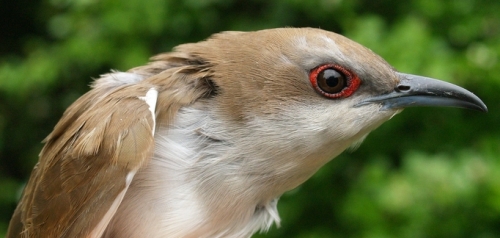
Black-billed Cuckoo is a relatively rare species at MBO, not observed annually. This one was our first ever banded in spring, and only our sixth in any season.
(Photo by Simon Duval)
|
The list of species banded for the first time this spring was a longer one this week, including the aforementioned Black-billed Cuckoo, plus Yellow-bellied Sapsucker, four flycatchers (Traill's, Yellow-bellied, Great Crested, and Eastern Kingbird), Red-eyed Vireo, and two of the later warbler migrants (Black-throated Green and Mourning).
This week’s
top 10
#
individuals banded |
mean # individuals observed daily |
1. Tennessee Warbler (46) [2] |
1. Red-winged Blackbird (39) [1] |
2. Blackpoll Warbler (31) [5] |
2. Cedar Waxwing (25) [5] |
3. Cedar Waxwing (24) [-] |
3. Tree Swallow (20) [9] |
4. Traill's Flycatcher (17) [-] |
4. Ring-billed Gull (17) [4] |
5. Northern Waterthrush (15) [5] |
5. Cliff Swallow (16) [-] |
6. Yellow Warbler (13) [10] |
6. Blackpoll Warbler (15) [-] |
7. Magnolia Warbler (12) [5] |
7. American Crow (15) [3] |
8. Wilson's Warbler (8) [-] |
8. Yellow Warbler (15) [6] |
9. Canada Warbler (7) [-] |
9. Tennessee Warbler (14) [-] |
9. Common Yellowthroat (7) [4]
9. American Goldfinch (7) [-]
|
10. American Goldfinch (11) [10] |
|
The top two spots on this week's list of species banded are remarkably reminiscent of this week in 2009, when we banded 44 Tennessee and 25 Blackpoll Warblers - and a dramatic difference from last year, when our spring totals for these species were 7 and 6, respectively. Cedar Waxwing continued its erratic spring at MBO, bouncing back on the list in third place. However, the biggest surprise of the week might be Traill's Flycatcher, considering that our previous record for a full spring season was only 15. Interestingly though, this marks the third consecutive year the species has been in the top 10 during week 9, rising in rank each year, after having missed the list in all previous years. The Northern Waterthrush count was also strong, matching the best previous count of 15 in week 8 of 2009. Just making it on the list in a tie for ninth place was American Goldfinch, which has been unusually scarce so far this spring, with just 16 individuals banded to date (compared with between 32 and 111 in previous spring seasons). Five more warblers rounded out the top ten, with Canada Warbler standing out, given that the seven banded this week amount to half of our cumulative total over the previous six spring seasons! Again there was a lot of turnover in this week's list, with Nashville Warbler, Yellow-rumped Warbler, American Redstart, Red-winged Blackbird, and Baltimore Oriole dropping off from the week 8 edition.
Among species observed, Red-winged Blackbird remained on top for a second week in a row, not surprisingly as it has always been among the top two in week 9. More unexpected was Cedar Waxwing in second place, its highest ever ranking at this time of spring, and with considerably more individuals present than the previous week 9 high of 16 per day. Both Tree and Cliff Swallows moved up significantly this week, while Ring-billed Gull stayed put in fourth place again. Rounding out the list were regular suspects American Crow and American Goldfinch, as well as three warblers. The mean daily count of 15 Blackpoll Warblers was a new record high for MBO in any season, and the same is true of the 14 Tennessee Warblers. Falling out of the top ten this week were Canada Goose (for the first time this spring), Yellow-rumped Warbler, and Baltimore Oriole.
|
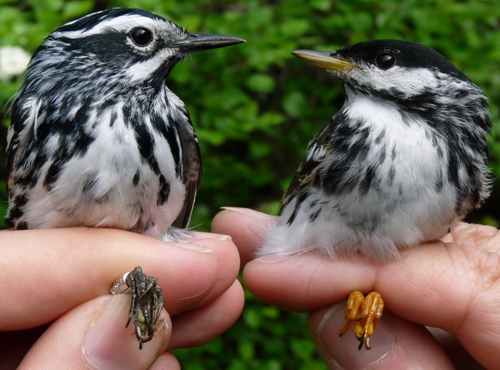
A nice comparison of male Black-and-white (left) and Blackpoll (right) Warblers, highlighting not only the difference in facial patterns, but also the distinct contrast in foot colour between the two species.
(Photo by Marcel Gahbauer)

Another convenient comparison from the same morning as the warblers above was this pair of small Empidonax flycatchers, with Least on the left and Yellow-bellied on the right (we got Traill's just a bit too late for a three-species portrait).
(Photo by Marcel Gahbauer)
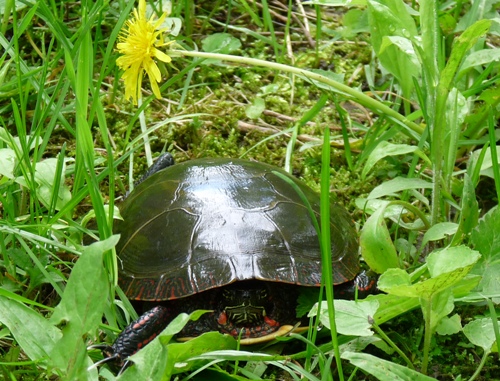
With all the rain this May, it is so wet everywhere at MBO that this wayward Painted Turtle was wandering along "Warbler Alley" of the census trail, a fair distance from the ponds.
(Photo by Marcel Gahbauer)
|

